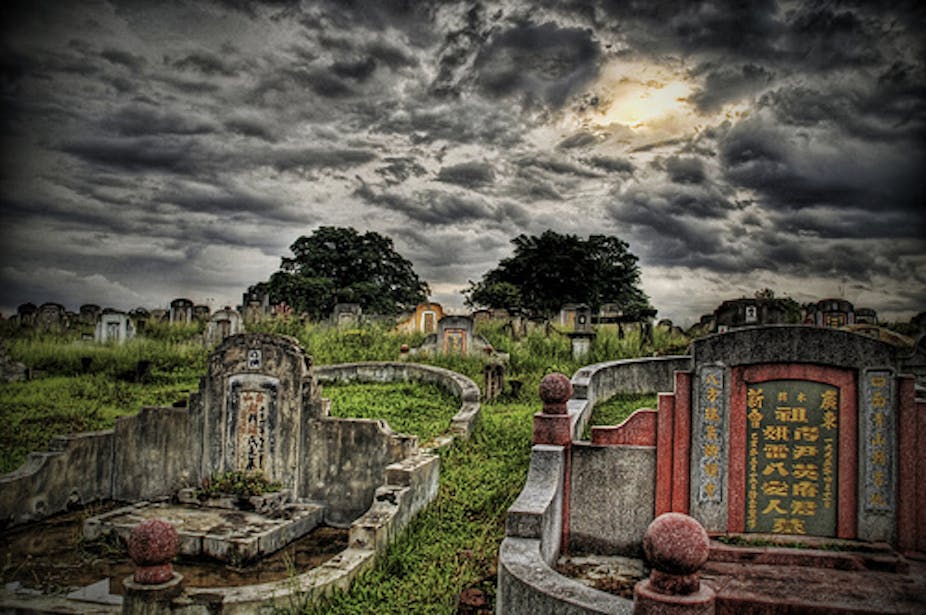How we die, as well as how we live, has profound and lasting effects on the environment. Nowhere is this more true than in China, the most populous nation on Earth.
According to the National Bureau of Statistics, 9.6 million people died in mainland China during 2011. Considering that between 2000 and 2009 the average rate of cremation was 50%, nearly 5 million corpses were cremated in 2011.
Every cremation creates about 160 kg of carbon dioxide (CO2), so in China at least 760,934 tons of CO2 were discharged into the atmosphere in that year - not including that generated by burning the belongings of and sacrificial offerings for the dead.
In the coming years, more and more CO2 will be discharged from crematoria as China enters the so-called ageing society. More people die, and there is great promotion of cremation by the Chinese government. For example, it is estimated that about 5.65 million corpses will be cremated in 2015. That is 890,000 more than the number in 2011, discharging an additional 143,066 tons of CO2.

Apart from releasing CO2, every cremation uses electricity and fossil oil, and emits other pollutants into the atmosphere, such as sulfur dioxide, nitrogen oxides, monoxide, hydrocarbons, hydrogen sulfide, ammonia, hydrogen chloride, hydrogen fluoride, mercury, and persistent organic pollutants.
The original idea of promoting cremation in 1950s by the government was to save farmland from traditional burials under the ground. However, although comparatively less, cremation also uses huge amounts of land. It is estimated that at least 13,333 hectares of land have been used for crematoria, funeral parlours, cemeteries for placing the cremated ash, and more and more cremation funeral and internment facilities and services are being built.
Greener options
It was not always this way. During the Xi Zhou dynasty (1066 - 771 B.C.), in order to encourage people to plant trees, it was ruled that the person would not be allowed to use a wood coffin after death if they had not planted any trees in their life.
Ceasing cremation of the dead can bring about a significant energy saving and pollution reduction. Instead of cremation, natural earth burials should be promoted, which here means to bury the corpse in a simple and biodegradable bag or container under a tree, without building stone tombs or erecting tombstones, and therefore without occupying land, especially farmland.
As the annual death numbers approach 10 million, by practising natural earth burials, China can save some 10 million square metres of land every year that are used for tombs and cemeteries for placing the ash. It can reduce 904,000 tons of CO2 that are emitted to the atmosphere and will see planting of at least an additional 10 million trees every year.
Natural earth burials do not require cremation and management of the tombs, and can therefore greatly reduce the human and material management leading to further energy saving and emission reduction. In addition, the planted trees can absorb CO2 and release oxygen.
In China, most people live in concrete apartment homes their whole life. It is silly that our remains are placed in a concrete compartment under the ground after death in the form of cremated ash. This cuts off the natural circle of human body in the environment.
As a human, from birth to death, our body has been constantly taking from the environment for survival - inhaling O2, exhaling CO2, eating cereals, vegetables and meats. But how can we have the heart to damage the environment even further by getting our body burned after death, rather than paying the environment back? The sensible answer is to have our body buried under the ground in an environmentally friendly way.
A natural cycle
When our body is decomposed it becomes the fertiliser and part of the soil. It is part of a virtuous circle linking humans to the environment. Traditionally, Chinese people believe Ru Tu Wei An, which means the soul of the dead can only be at peace if the dead body is buried in the soil. But the traditional burial under the ground is not good practice because it uses a great amount of high quality wood for the coffin and occupies a lot of land for the tomb.

The great news is that natural earth burials not only meet this traditional belief, but also make a lot of sense ecologically. Natural earth burial is a better way of continuing our life after death. What could be better than becoming a tree after death?
Traditionally, it is believed in China that the natural world is composed of five elements: metal, wood, water, fire, and earth, of which wood is the sole element that has life. Wood represents the living tree. The essence of the tree is to penetrate deep into the soil and draw life from the depths, to build the strength and solidarity of a trunk and to display its fullness against the sky through its branches and foliage which benefit the kingdom of animals including humans by absorbing CO2 and releasing O2.

